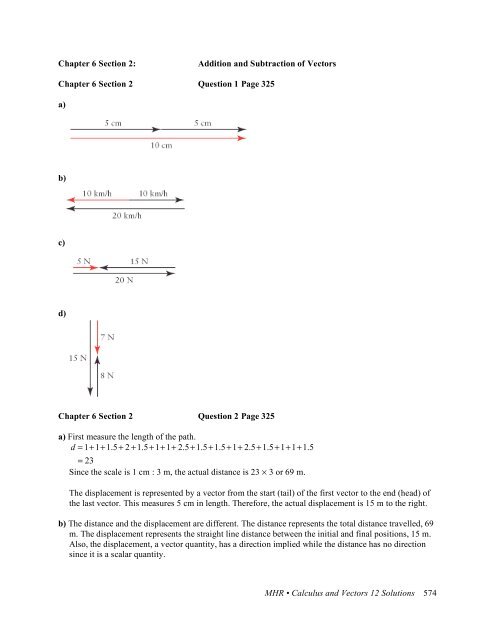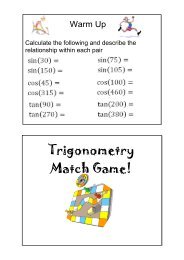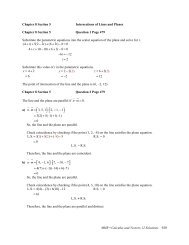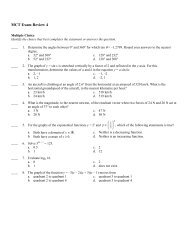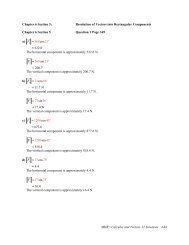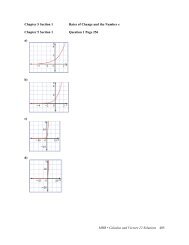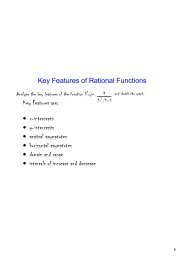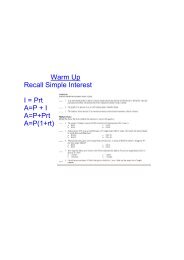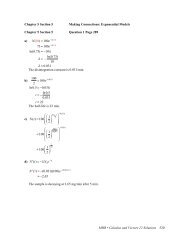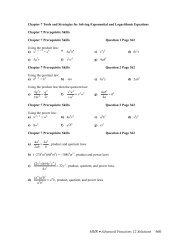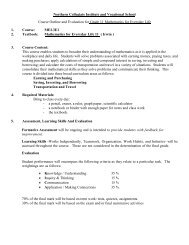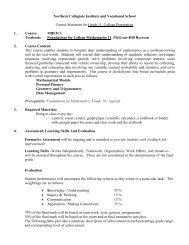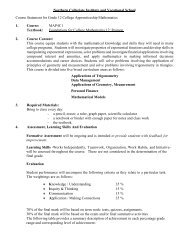MHR • Calculus and Vectors 12 Solutions 574 Chapter 6 Section 2 ...
MHR • Calculus and Vectors 12 Solutions 574 Chapter 6 Section 2 ...
MHR • Calculus and Vectors 12 Solutions 574 Chapter 6 Section 2 ...
You also want an ePaper? Increase the reach of your titles
YUMPU automatically turns print PDFs into web optimized ePapers that Google loves.
<strong>Chapter</strong> 6 <strong>Section</strong> 2:<br />
Addition <strong>and</strong> Subtraction of <strong>Vectors</strong><br />
<strong>Chapter</strong> 6 <strong>Section</strong> 2 Question 1 Page 325<br />
a)<br />
b)<br />
c)<br />
d)<br />
<strong>Chapter</strong> 6 <strong>Section</strong> 2 Question 2 Page 325<br />
a) First measure the length of the path.<br />
d = 1+1+1.5+ 2 +1.5+1+1+ 2.5+1.5+1.5+1+ 2.5+1.5+1+1+1.5<br />
= 23<br />
Since the scale is 1 cm : 3 m, the actual distance is 23 × 3 or 69 m.<br />
The displacement is represented by a vector from the start (tail) of the first vector to the end (head) of<br />
the last vector. This measures 5 cm in length. Therefore, the actual displacement is 15 m to the right.<br />
b) The distance <strong>and</strong> the displacement are different. The distance represents the total distance travelled, 69<br />
m. The displacement represents the straight line distance between the initial <strong>and</strong> final positions, 15 m.<br />
Also, the displacement, a vector quantity, has a direction implied while the distance has no direction<br />
since it is a scalar quantity.<br />
<strong>MHR</strong> <strong>•</strong> <strong>Calculus</strong> <strong>and</strong> <strong>Vectors</strong> <strong>12</strong> <strong>Solutions</strong> <strong>574</strong>
<strong>Chapter</strong> 6 <strong>Section</strong> 2 Question 3 Page 325<br />
Answers may vary. For example:<br />
a) The shortest vector is w !" !" " "<br />
; w = u ! v<br />
!!!" !!!" !!!" !!!"<br />
b) The shortest vector is AB ; AB=AC ! BC<br />
c) The shortest vector is RQ<br />
!!!" !!!" !!!" !!!"<br />
; RQ = PQ ! PR<br />
d) The shortest vector is e ! ! ! "!<br />
; e = v ! f<br />
<strong>Chapter</strong> 6 <strong>Section</strong> 2 Question 4 Page 325<br />
!!!"<br />
a) AB<br />
!!!"<br />
b) BD<br />
!!!"<br />
c) AC<br />
!!!"<br />
d) AC<br />
!!!"<br />
e) BC<br />
!!!"<br />
!!!"<br />
f) AB ! DB<br />
(parallelogram method)<br />
(parallelogram method)<br />
!!!"<br />
= AB<br />
!!!"<br />
+ BD<br />
!!!"<br />
= AD<br />
!!!"<br />
!!!"<br />
!!!"<br />
!!!"<br />
!!!"<br />
!!!"<br />
g) AB ! CB ! DC = AB + BC + CD<br />
!!!"<br />
= AD<br />
h) The vectors form a triangle.<br />
!!!"<br />
!!!<br />
" !!!"<br />
!!!"<br />
!!!"<br />
!!!"<br />
AE ! EB ! BC = AE + BE + CB<br />
!!!"<br />
!!!"<br />
!!!"<br />
= AE + ED + DA<br />
"<br />
= 0<br />
<strong>Chapter</strong> 6 <strong>Section</strong> 2 Question 5 Page 326<br />
Since the hexagon is regular, all sides are equal <strong>and</strong> all interior angles are equal. Consequently opposite<br />
sides are equal <strong>and</strong> parallel. Also, the interior triangles formed with the centre are equilateral triangles.<br />
!!!"<br />
!!!"<br />
!!!"<br />
AB = AO + OB<br />
!!!"<br />
!!!"<br />
= !OA + OB<br />
!!!"<br />
!!!"<br />
= OB ! OA<br />
" "<br />
= b ! a<br />
<strong>MHR</strong> <strong>•</strong> <strong>Calculus</strong> <strong>and</strong> <strong>Vectors</strong> <strong>12</strong> <strong>Solutions</strong> 575
!!!"<br />
OC<br />
!!!"<br />
CO<br />
!!!"<br />
AE<br />
!!!"<br />
= AB<br />
"<br />
"<br />
= b ! a<br />
!!!"<br />
= !OC<br />
"<br />
"<br />
= !(b ! a)<br />
" "<br />
= !b + a<br />
" "<br />
= a ! b<br />
!!!"<br />
!!!"<br />
= AO + OE<br />
!!!"<br />
!!!"<br />
= !OA ! OB<br />
" "<br />
= !a ! b<br />
<strong>Chapter</strong> 6 <strong>Section</strong> 2 Question 6 Page 326<br />
a)<br />
b)<br />
c)<br />
<strong>MHR</strong> <strong>•</strong> <strong>Calculus</strong> <strong>and</strong> <strong>Vectors</strong> <strong>12</strong> <strong>Solutions</strong> 576
<strong>Chapter</strong> 6 <strong>Section</strong> 2 Question 7 Page 326<br />
Answers may vary. For example:<br />
a)<br />
b)<br />
Use The Geometer’s Sketchpad® to draw a scale diagram. Use a scale of 1 cm : 33.3 N. Let O<br />
!!"<br />
represent the knot. The resultant vector is OJ . The magnitude of the resultant force on the knot is 17.3<br />
N. The direction of the resultant force on the knot is upward if Allen’s force is directly to the left<br />
(000°).<br />
It is also possible to solve this problem using trigonometry involving the sine law, solving triangle<br />
OAN first <strong>and</strong> then triangle NOJ.<br />
<strong>MHR</strong> <strong>•</strong> <strong>Calculus</strong> <strong>and</strong> <strong>Vectors</strong> <strong>12</strong> <strong>Solutions</strong> 577


